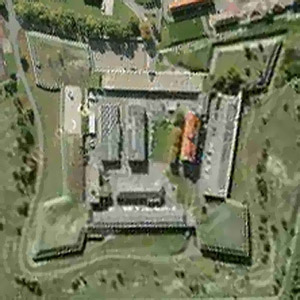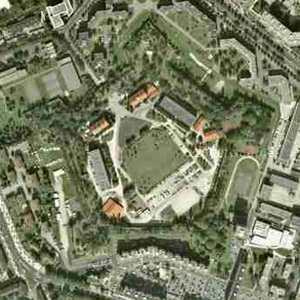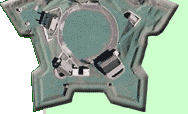 |
The city of Paris sits in a basin, surrounded by high ground. Fortifications of varying types have been emplaced in and around Paris probably since the first French caveman pissed off the first German caveman and got his butt kicked. Well, actually, the Wall of Phillipe Augustus is the first known Parisian enclosure: King Philippe Augustus (1165-1223) had it built from 1190 to 1215. King Charles V (1338-1380) had a new wall built around the growing city from 1356 to 1383, but Louis XIV (1638-1715) demolished those crumbling walls in 1670, leaving Paris open for all to come and go. Vauban recommended the enclosure of Paris in 1689, including some fortifications on nearby high ground and citadels facing both the east and west to delay the advancing hordes that he figured would soon be approaching for one reason or another. Despite Vauban being undoubtedly the wisest man in France at that time, the king ignored him and instead built the Wall of the Farmers-General, a vastly unpopular project aimed not at the city's defense but in the interest of assuring taxes on all goods entering Paris would be collected. |
 |
 |
The nations allied against Napoleon Bonaparte(1769-1821) occupied Paris in 1814 and again in 1815. Once left to their own devices, the authorities in Paris spent the next 25 years arguing about how the city could best be defended from future enemies. Belgium, meanwhile, had been spending its time since Napoleon's defeat fighting for its independence from the United Kingdom of the Netherlands, and in 1839 the Treaty of London, guaranteeing the sovereignity of the Kingdom of Belgium, was signed by all of Europe's powers...sans France, which was not invited to the treaty signing.
Excluded from this important process, French Prime Minister Adolphe Thiers (1797-1877) convinced King Louis-Philippe (1773-1850) that |
another invasion of France was imminent, and work begain on the Thiers Wall in 1841. By 1845, Paris had an incredible array of defenses: 16 lovely star forts, 22 smaller forts, and at least 11 separate batteries, all lovingly enclosed in a 33 kilometer long wall with a sloping glacis 250 meters wide around it. There was much concern from the left that such a massive military presence in the city was intended as much for the suppression of the always touchy Paris mob as it was to defend against invaders, but fortify the French did, and they fortified hard.
Having spent around 120 million francs on the defense of its capital, France cruised through the rest of the 19th and 20th centuries in complete security from its neighbors. Okay, not really.
|
Napoleon III (1808-1873) was elected president of France in 1848: Initiated a coup dissolving the National Assembly in 1851: Established himself as Emperor in 1852. The man who served as both France's first elected president and last monarch declared war on Prussia on July 13 1870, and menacingly crossed the German border on August 2. The Prussian steamroller drove the French inexorably back and comprehensively defeated the French army on September 2, capturing Napoleon III and some 104,000 French soldiers at Sedan.
Understandbly freaking out, the authorities left in Paris proclaimed an end to the Empire and the beginning of the French Republic, but the Prussian army kept coming anyway. They |
 |
 |
arrived at the closed Thiers Wall on September 19 and laid seige to the city. Some of Paris' 16 star forts served the Prussian army well, as they were used to bombard the forts that still had French people in them.
Paris held out until January of 1871, when on the 28th the Treaty of Versailles was signed, giving the Prussians all of the Paris forts and their armaments, as well as disarming the Thiers Wall. The Prussians occupied the pointy forts until September 1871, when they had finally sucked Paris dry, and went home.
By 1885, 700 million more francs had been spent on another huge mass of forts, works and batteries around France...which once again proved to do them no good whatsoever, as Germany stomped back into France in the First World War (1914-1918). Improvements in artillery, most notably the Germans' Paris Gun with a range of 120 kilometers, had by then pretty much rendered walls (and star forts!) irrelevant.
In 1919 Paris finally gave up on its impregnable wall. It had to buy the property on which the Thiers Wall stood from the State of France for 100 million francs in order to demolish it, but the city agreed not to build on the 250 meter wide "zone" that served |
 |
 |
as the wall's sloping glacis. The wall was mostly demolished, but slums had begun to take root in the zone in the late 19th century: There is a French slang word, zonard, that is used as an unkind name for a young male from these slums. During the Second World War (1939-1945) the nazis used at least one of Paris' forts, Fort du Mont-Valerien, as a headquarters and convenient place at which to murder French people. Today, most of these forts still stand in Paris, in varying states of overgrowth: Some, such as Fort de Noisy, actually look to have been kept shrub-free, but most of the others look like star-shaped arboretums. |
|
 |










